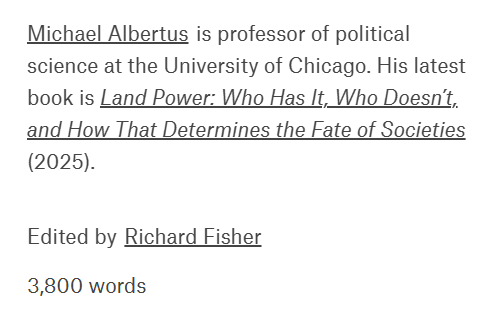Property rights amid the 'great land reshuffle'
 https://aeon.co/essays/the-great-land-reshuffle-thats-transforming-property-rights
https://aeon.co/essays/the-great-land-reshuffle-thats-transforming-property-rights
 Northward. Panaevsk, a Nenets settlement in the tundra situated on the banks of the Ob River, Western Siberia, Russia. Photo by Elena Chernyshova/Panos Pictures
Northward. Panaevsk, a Nenets settlement in the tundra situated on the banks of the Ob River, Western Siberia, Russia. Photo by Elena Chernyshova/Panos Pictures

As I cycle from downtown Chicago to my university’s campus, I pass over a complicated and consequential history with the land. Just over two centuries ago, the Chicago area was swampy, fur-trading land for Indigenous tribes. Most prominent among them were the Ojibwe, the Odawa and the Potawatomi, together known as the Council of the Three Fires. These tribes had collective rights to land and rotated hunting grounds. Much has changed since.
After war and disease weakened the tribes, the United States government claimed the grasslands, forests and, most crucially, the land around the Chicago River in the wake of the War of 1812. It then passed into the hands of the state of Illinois, followed by a canal commission, which in turn sold it to private buyers. As I set out on my bike, I ride through a public park that was once a frontier US Army post and later became a dumping ground for charred ruins following the Great Fire of 1871. I then pedal past the site of skirmishes between the US Army and local tribes, and between a set of beaches and neighbourhoods where racialised battles for land zoning and development played out between Black people, white people and the city since the time of the Great Migration. Arriving at my campus, I reach land owned by the University of Chicago that was bought in the late 1800s by the department-store owner Marshall Field, who subsequently donated it to John D Rockefeller to host the university, founded in 1891.
It can be easy to forget the significance of the ground beneath our feet – and how much it has shaped the societies we live in. For most people, their home is their house – or their landlord’s. It is bought, sold or rented along with the land underneath it, passing between families over the years. But at some point – and probably several times – there have been abrupt changes to that seemingly permanent arrangement. Land tenure can be profoundly reshuffled. It has in the past and it will be again in the future.
As a political scientist, I’ve studied how land power has shaped societies all over the world. From Ireland to Italy, from Chile to South Africa, and across the US West, struggles over ownership and land use are etched in family histories and have determined the fate of nations. In windswept mountains near Cuzco, Peru, for instance, I met a woman who recounted growing up as a forced worker on a private estate with colonial roots: in her 20s, that land was seized by the government and passed over to the community, which later broke it up into family plots. Another man I spoke with recently in South Africa told me of his parents’ forced displacement under apartheid. Their land was planted by a sugar company, but in 2008, it was returned to the community, who now lease it to the same company. And in Patagonia National Park in southern Chile, I recently hiked through grass-covered steppe that had, in the course of a century, passed from a natural, episodically transited landscape to an enclosed private ranch, a multi-family government cooperative, back to a private ranch, and then into the hands of a philanthropist who passed it to the government for conservation.
snip


